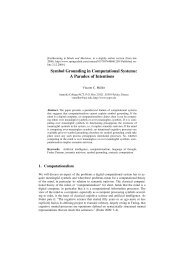Theory and Philosophy of Artificial Intelligence - Vincent C. Müller
Theory and Philosophy of Artificial Intelligence - Vincent C. Müller
Theory and Philosophy of Artificial Intelligence - Vincent C. Müller
You also want an ePaper? Increase the reach of your titles
YUMPU automatically turns print PDFs into web optimized ePapers that Google loves.
artificial. On this classical view, AI <strong>and</strong> Cognitive Science are two sides <strong>of</strong> the same<br />
coin – this view had fuelled a large part <strong>of</strong> the philosophical <strong>and</strong> theoretical interest in<br />
AI. However, most <strong>of</strong> the defining features <strong>of</strong> this old consensus are now under threat:<br />
computation is digital; representation is crucial for cognition; embodiment, action <strong>and</strong><br />
interaction are not; the distinction between living <strong>and</strong> non-living agents is irrelevant;<br />
etc. So, should we drop the classical view, should we supplement it, or should we<br />
defend it in the face <strong>of</strong> modish criticism? These philosophical debates are mirrored in<br />
technical AI research, which has been moving on (for the most part), regardless <strong>of</strong> the<br />
‘worries’ from the theorists; but some sections have changed under the impression <strong>of</strong><br />
classical criticism while new developments try to shed the classical baggage entirely. In<br />
any case, the continued technical success has left an impression: We are now much<br />
more likely to discuss human-level AI (whatever that means) in machines as a real<br />
possibility.<br />
Given where we st<strong>and</strong> now, the relation between AI <strong>and</strong> Cognitive Science needs to<br />
be re-negotiated – on a larger scale this means that the relation between technical<br />
products <strong>and</strong> humans is re-negotiated. How we view the prospects <strong>of</strong> AI depends on<br />
how we view ourselves <strong>and</strong> how we view the technical products we make; this is also<br />
the reason why the theory <strong>and</strong> philosophy <strong>of</strong> AI needs to consider such apparently<br />
widely divergent issues from human cognition <strong>and</strong> life to technical functioning.<br />
3. What now?<br />
A bewildering mass <strong>of</strong> questions spring to mind: Should we repair classical AI, since<br />
intelligence is still input-output information processing? Drop the pretence <strong>of</strong> general<br />
intelligence <strong>and</strong> continue on the successes <strong>of</strong> technical AI? Embrace embodiment,<br />
enactivism or the extended mind? Revive neural networks in a new form? Replace AI<br />
by ‘cognitive systems’? Look for alternative systems, dynamic, brain-inspired, …? And<br />
what about the classical problems that Dreyfus, Searle, Haugel<strong>and</strong> or Dennett had<br />
worked on; what about meaning, intention, consciousness, expertise, free will, agency,<br />
etc.? Perhaps AI was blind in limiting itself to human-level intelligence, so why not go<br />
beyond? What would that mean <strong>and</strong> what would its ethical implications be? What are<br />
the ethical problems <strong>of</strong> AI even now <strong>and</strong> in the foreseeable future?<br />
The discussion on the future <strong>of</strong> AI seems to open three different directions. The first is<br />
AI that continues, based on technical <strong>and</strong> formal successes, while re-claiming the<br />
original dream <strong>of</strong> a universal intelligence (sometimes under the heading <strong>of</strong> ‘artificial<br />
general intelligence’). This direction is connected to the now acceptable notion <strong>of</strong> the<br />
‘singular’ event <strong>of</strong> machines surpassing human intelligence – it plays a central role in<br />
Bostrom’s <strong>and</strong> Dreyfus’ papers here.<br />
The second direction is defined by its rejection <strong>of</strong> the classical image, especially its<br />
rejection <strong>of</strong> representation (as in Brooks’ ‘new AI’), its stress <strong>of</strong> embodiment <strong>of</strong> agents<br />
<strong>and</strong> on the ‘emergence’ <strong>of</strong> properties, especially due to the interaction <strong>of</strong> agents with<br />
their environment – O’Regan is a clear example <strong>of</strong> this direction.



